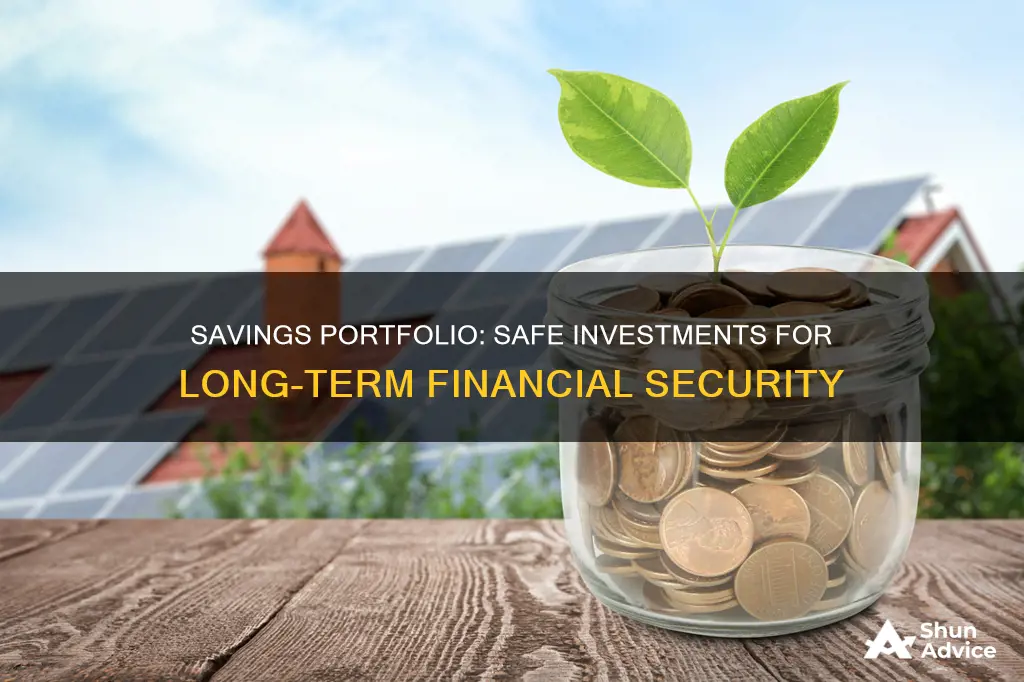
When it comes to building a savings portfolio, there are a variety of investment options available, each with its own level of risk and potential returns. While some investments offer higher returns, they also come with a greater risk of loss. Safe investments, on the other hand, prioritize capital preservation over high returns, providing stability and protection against market volatility. These investments are particularly suitable for risk-averse individuals, those nearing retirement, or anyone seeking to balance out higher-risk investments. Examples of safe investments include U.S. Treasury securities, money market funds, high-yield savings accounts, certain types of bonds and annuities, and CDs (Certificates of Deposit). Diversification is key, and experts recommend a portfolio that includes a mix of low-, moderate-, and high-risk investments tailored to individual goals, timelines, and risk tolerance.
| Characteristics | Values |
|---|---|
| Risk | Minimal risk of loss, stable but modest returns |
| Liquidity | Good liquidity |
| Returns | Low returns |
| Tax | Tax advantages |
| Inflation | Protection against inflation |
| Diversification | Diversified portfolio |
| Safety | Safety net of low-risk investments |
| Volatility | Low price volatility |
| Investment type | Money market funds, U.S. Treasury securities, high-yield savings accounts, municipal bonds, corporate bonds, bond funds, dividend stocks, cash, CDs, annuities |
What You'll Learn

US Treasury securities
Treasury securities have a fixed interest rate and a set maturity date, providing investors with predictability and stability. They also have a low inflation risk because interest rates are set by the market and adjusted for inflation. This makes Treasury bills, notes, and bonds reliable choices for those seeking to minimize risk in their investment portfolios. Treasury bills, or T-bills, are issued with maturities of 52 weeks or less and are considered low-risk. Treasury notes are issued with maturities of 2 to 10 years.
Treasury Inflation-Protected Securities (TIPS) are government bonds that protect against the risk of inflation. The value of the principal rises or falls over the term of the security, depending on the current rate of CPI inflation. If the principal is higher than the original investment at maturity, the investor keeps the increased amount. TIPS are sold in terms of five, 10, or 30 years.
To buy Treasury securities, investors can visit the US Treasury Department's official website or go through a broker. Treasury exchange-traded funds (ETFs) and mutual funds, which offer a diversified portfolio of Treasury bonds, can be purchased through most major online brokers or financial institutions. It is important to research the different types of Treasury investments available before making a purchase. The value of these investments may fluctuate with changes in interest rates and market conditions.
India's Future: Investing in Petro?
You may want to see also

Money market funds
When considering money market funds, it is important to remember that they may not be suitable for long-term investing, as they typically offer lower returns compared to riskier assets. However, they can provide a stable option for investors seeking to balance out higher-risk investments or protect their capital during volatile market conditions.
Overall, money market funds can be a valuable component of a diversified portfolio, offering safety, liquidity, and predictable income for investors with varying financial goals, timelines, and risk tolerances.
A Beginner's Guide to Investing in Bitcoin in India
You may want to see also

High-yield savings accounts
One of the key advantages of high-yield savings accounts is their ability to provide stability and predictable income. They serve as a reliable safety net during volatile market conditions, helping you ride out rough patches and ensuring liquidity when you need it. This stability is especially important when planning for retirement, as it allows you to maintain your purchasing power despite market fluctuations.
When considering high-yield savings accounts, it's important to remember that not all accounts are created equal. Different financial institutions offer varying interest rates, fees, and minimum balance requirements. For example, the E*TRADE Premium Savings Account offers a reasonably high yield and double the minimum FDIC insurance, while the Varo savings account is ideal for new savers building an emergency fund, offering a 2.50% APY for balances under $5,000 and 5.00% APY for higher balances.
It's also worth noting that high-yield savings accounts can help mitigate the risk of inflation. While traditional savings accounts may struggle to keep pace with rising prices, high-yield accounts can provide returns that outpace inflation, preserving the value of your savings. Treasury Inflation-Protected Securities (TIPS), for instance, are government bonds that protect your principal from inflation by adjusting their value based on the current CPI inflation rate.
In summary, high-yield savings accounts are an essential component of a well-diversified portfolio. They offer stability, liquidity, and protection against market volatility. When choosing a high-yield savings account, be sure to compare interest rates, fees, and minimum balance requirements to find the best option for your financial goals and risk tolerance. By including these accounts in your investment strategy, you can effectively balance risk and return while preserving and growing your capital.
Investment Advisors: Risk or Reward?
You may want to see also

Municipal bonds
When considering municipal bonds, it is important to assess your overall investment mix of stocks and bonds, as well as the type of account you are investing in. Municipal bonds can play an important role in a diversified portfolio, but they may not provide the high returns of riskier assets.
There are different types of municipal bonds to consider, such as general obligation bonds and revenue bonds. General obligation bonds are used for projects that are unlikely to generate revenue, while revenue bonds are paid back with revenue from specific projects, such as toll roads or entertainment centers.
In summary, municipal bonds offer tax advantages, low default risk, and stability, making them a safe investment option for building a savings portfolio. However, it is always important to consider your individual financial goals, risk tolerance, and overall investment strategy when making investment decisions.
Warren Buffett's Private Equity Investment Strategy Explored
You may want to see also

Diversification
Across asset classes: Different asset classes, such as stocks, bonds, cash, and alternative investments, tend to perform differently in different market conditions. For example, when stocks perform well, bonds may not, and vice versa. By investing in multiple asset classes, you can smooth out the returns and reduce the overall risk of your portfolio. This is known as "asset allocation".
Within asset classes: Diversification can also be achieved within an asset class. For example, within equities, you can invest in a variety of sectors, such as technology, healthcare, financials, and consumer goods. This helps to reduce the impact of any one sector's performance on your portfolio. Similarly, within fixed-income investments, you can invest in a range of bonds with different maturities, credit ratings, and issuers.
Geographic diversification: Investing in companies and assets from different countries and regions can also help spread risk. Different countries and regions have different economic cycles, political environments, and market conditions, which can affect the performance of their respective assets. By investing globally, you can capture growth opportunities in multiple markets and reduce the impact of any one country or region's performance.
Industry and sector diversification: Different industries and sectors can be affected differently by economic and market conditions. For example, the technology sector may perform well when innovation is high, while consumer staples may be more resilient during economic downturns. By investing in a variety of industries and sectors, you can lower the impact of any one sector's performance on your portfolio.
Time diversification: This strategy, also known as "dollar-cost averaging", involves investing regularly over time instead of investing a lump sum all at once. By investing a fixed amount at regular intervals, you can reduce the risk of investing all your money at a market peak. Time diversification helps to smooth out the impact of market volatility and can lead to better long-term returns.
It is important to note that while diversification can help reduce risk, it does not guarantee profits or completely eliminate risk. Markets and assets can move in tandem during certain events, and diversification may not protect against losses in all scenarios. Additionally, the level of diversification required depends on your risk tolerance, investment goals, and time horizon.
DSP BlackRock: A Safe Investment Bet?
You may want to see also
Frequently asked questions
Safe investments include US Treasury securities, money market funds, high-yield savings accounts, municipal bonds, and certain types of annuities and stocks.
Treasury securities are government bonds that protect your money from inflation. They are considered one of the safest investments as they are backed by the US government.
Safe investments provide stability and predictable income. They also protect against market volatility and the risk of loss.
Safe investments typically yield lower returns than riskier assets. They may also have varying degrees of liquidity and tax implications.
Experts suggest allocating around 10% to 20% of your portfolio to safe investments. However, the percentage depends on your financial situation, risk tolerance, and investment goals.







